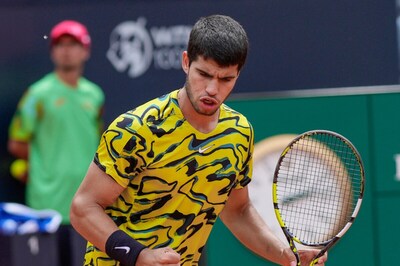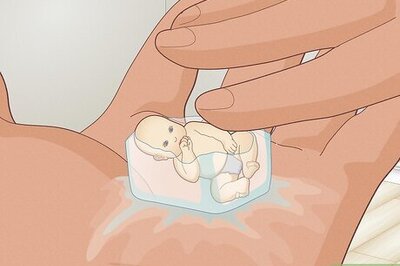
views
Heinz Guderian- the famous German General- who also led the Panzers across the Dnieper river at Kopys during World War II had once stated, “If the tanks succeed, then victory follows.” However, since the beginning of the Ukraine War, most analysts have been talking about the ‘demise’ of the tank and questioning its centrality in light of the proclaimed success of drones, Javelins and other anti-tank weapons. In fact, while condemning the brutality of the war in Ukraine, Pope Francis in an interview with the Italian newspaper Corriere della Sera said that the Russians are discovering that “their tanks are useless.” Ironically, we now see a scramble by Ukraine to obtain the latest tanks.
The onset of the winter has now provided the North Atlantic Treaty Organisation (NATO) a narrow window to arm Ukraine to repel an anticipated Russian springtime offensive. They are, therefore, moving fast to give them sophisticated weapons they had earlier refused, for fear of provoking Russia.
The sense of urgency over sending more powerful weapons reflects the grim standoff on the battlefield in Eastern Ukraine, where the Russians are trying to seize the city of Bakhmut and the surrounding area but have only made incremental gains. Though they have been successful in Soledar– a salt mine town inhabited by 10,000 people.
Over the last few weeks, one barrier after another has fallen, starting with an agreement by the United States in late December to send the Patriot Air Defence System. That was followed by a German commitment last week to provide a Patriot missile battery and then France, Germany and the United States each promised to armoured fighting vehicles, mainly the Bradleys to the front line for the first time.
Now the spotlight is on the induction of modern Western tanks to the growing list of powerful weapons being sent Ukraine’s way. Until now, Ukraine has relied primarily on Soviet-era T-72 tanks. These also include T-72 tanks given by the NATO countries that were members of the Warsaw Pact. In fact, Poland has given them 260 T-72 tanks of various modifications as per the statement by Polish President Andrzej Duda during the discussion panel ‘Defending Europe’ at the World Economic Forum (WEF) in Davos.
Under the so-called ‘Ringtausch’ programme, a swap scheme, Eastern NATO partners supplied the Ukrainian Army with Soviet-era tanks like the T-72 in exchange for the Leopards from Germany, and the exchange rate was not one-for-one. However, most of Ukraine’s tank fleet has been destroyed and has suffered wear and tear due to the prolonged conflict, and is running low on ammunition, which is incompatible with Western munitions.
The impasse over tanks now seems to be ending with the UK announcing that it would be sending 14 Challenger 2 tanks to Ukraine, making it the first country to send Western-made battle tanks to Kyiv. While countries like Poland, Finland and the Baltic states have also openly endorsed re-exporting Leopard 2 tanks to Ukraine from their own stocks, they require Germany’s permission to do so.
President Zelenskyy thanked the UK for its support, saying the decision would “not only strengthen Ukraine on the battlefield but also send the right signal to other partners.” “Somebody always has to set an example” is what he told the Polish state-run broadcaster TVP Info.
Russia has reacted with fury, saying that all the units that the UK plans to send “will burn” and “do nothing to alter the outcome of its nearly year-long war.” Vladimir Solovyov, a presenter on the Rossiya-1 state television channel said the UK had “de facto entered the war” with its move to supply the units. “I consider Britain is now a legitimate target for us,” he said.
While Ukraine has been requesting sophisticated tanks since the start of the war, the push to satisfy those pleas gained speed as the British and Polish governments publicly urged a change in the Western alliance’s stance. While the British have agreed to send a small number of tanks, the Polish government said it would happily send some of its Leopard tanks, though Germany would need to allow it.
Ukraine hopes that the increased pressure will persuade Germany’s Chancellor Olaf Scholz to authorise the export of German-made Leopard 2 tanks, held by other NATO allies, to Ukraine. The tanks are among the most coveted weapon platform and if inducted in significant numbers, they would substantially increase Ukraine’s capabilities.
A German Defence Ministry spokesman said no decision had been made by the government of Chancellor Scholz, a Social Democrat. But his coalition partners– the Greens and Free Democrats– support sending the tanks.
Norbert Röttgen, an Opposition German Legislator and foreign-policy expert, has predicted that Scholz would give in on the Leopards under pressure from allies, as he did earlier with German-made howitzers and tracked armoured infantry fighting vehicles.
Scholz and his party “wants to keep a relationship with Russia and with Putin for the future, and think that if they give Ukraine the best Germany has, Russia will perceive this as breaking a special relationship,” Röttgen said. “But pressure from allies is becoming too strong,” he added.
Germany has been tight-lipped about the tanks despite increasing pressure and criticism. However, German arms manufacturer Rheinmetall (which makes the main gun for the Leopard 2) tried to manage mounting expectations of a decision on tanks, with the chief executive of the firm telling a German newspaper that Leopard 2s from Germany’s industrial reserves would not be ready for any kind of delivery before 2024.
There are an estimated 2000 Leopard tanks in more than a dozen countries across Europe and some could be shipped to Ukraine, though Ukrainian crews would have to be trained in using them.
In Ukraine, officials say armoured fighting vehicles will play a key role in battles for control of the fiercely contested towns and cities in the Eastern provinces. Ukraine’s General, Valeriy Zaluzhny, said “the nation needs some 300 Western tanks and about 600 Western armoured fighting vehicles to make a difference.”
There is no hiding the fact that tanks are logistics intensive. Moreover, the logistics for each type of tank varies not only as per the type of ammunition fired but also the fuel. Logistics sustenance, thus, plays a critical role in their employment. Then there is the issue of maintenance and repairs– both of which require a huge inventory. For example, while the T-72 and T-90 have a 125mm smoothbore gun, the Challenger 2 has a 120 mm rifled gun and the Leopard 2 has a 120 mm smoothbore gun manufactured by Rheinmetall. The US operates the M1 A2 which also has a 120 mm smoothbore gun, the quantities of which far outstrip the Challenger and Leopards tanks but they are seen unsuitable for Ukraine as they are driven by gas turbine engines. A handful of Challenger 2s, taken from the UK’s existing fleet of 227, would not in itself make much difference on the battlefield, but it would be the first time any Western country has agreed to send its own heavy armour to Ukraine. However, the Challengers have maintenance issues and the UK would be hard-pressed to replenish its stocks.
Altering the balance of forces in Eastern Ukraine is needed to break the stalemate in the war and modern Western battle tanks and other combat vehicles could tip the balance. Without tanks, a powerful component of ground warfare, it is unlikely that Ukraine will be able to win back significant amounts of territory.
Ms Laura K Cooper, a Deputy Assistant Secretary of Defence, last week at a briefing said, “We absolutely agree that Ukraine does need tanks. This is the right time for Ukraine to take advantage of its capabilities, to change the dynamic on the battlefield.”
Plans to send German-made Leopard tanks and UK Challengers to the front lines in the Donbas have been greeted by the Ukrainian forces, who have been taking heavy casualties in recent weeks, around Bakhmut.
“There were very heavy losses. It’s very pitiful. It’s hard,” said an officer in charge of repairing tanks for the 24th Mechanised Brigade. He said the current deadlock would not be broken unless foreign tanks arrive in significant numbers. “We’ll be stuck here. We need these Western tanks to stop Russia’s aggression. With infantry, covered by tanks, we’ll win for sure,” he said.
Battle tanks designed by the NATO countries such as Challenger 2 and Leopard 2 would provide Ukrainian forces with better protection and more accurate firepower. However, they would not provide an instantaneous boost in terms of combat capability because the Ukrainian forces would need to be trained to use any tanks supplied by the West, a process that is likely to take several weeks, if not longer. Conversion is a long drawn-out process focussed at an individual level, graduating to crew integration, sub-unit training and thereafter integrated and joint training. There is also the issue of maintenance and repairs, both of which have their own complexities.
With Russian troops fortifying their positions in occupied parts of Ukraine’s East and South and probably preparing for a new offensive in the months to come, battle tanks would provide Ukraine with a means to better defend itself and potentially make breakthroughs on the battlefield.
With the sudden resignation of Germany’s Defence Secretary, Christine Lambrecht, the decision on providing tanks is likely to be on top of the agenda of her successor Boris Pistorius.
While there have been narratives regarding the future of war based on the emergence of high-technology weapon systems and futuristic visions of battles contested in cyberspace and by other non-kinetic means, it is unlikely that an outcome of a conflict can be controlled without the use of force. The fact remains that to be able to constantly create criticalities for the enemy in all phases of operations, you need the tank. There is no doubt that in war, violence still dominates.
The author is an Army veteran. The views expressed in this article are those of the author and do not represent the stand of this publication.
Read all the Latest Opinions here
















Comments
0 comment